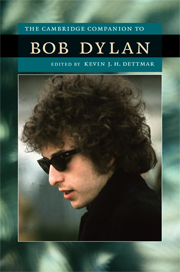Book contents
- Frontmatter
- Introduction
- Part I Perspectives
- Part II Landmark Albums
- 10 The Freewheelin’ Bob Dylan (1963)
- 11 Bringing It All Back Home (1965)
- 12 Highway 61 Revisited (1965)
- 13 Blonde on Blonde (1966)
- 14 The Basement Tapes (1967; 1975)
- 15 Blood on the Tracks (1975)
- 16 Infidels (1983)
- 17 “Love and Theft” (2001)
- Works cited
- Index
10 - The Freewheelin’ Bob Dylan (1963)
from Part II - Landmark Albums
Published online by Cambridge University Press: 28 May 2009
- Frontmatter
- Introduction
- Part I Perspectives
- Part II Landmark Albums
- 10 The Freewheelin’ Bob Dylan (1963)
- 11 Bringing It All Back Home (1965)
- 12 Highway 61 Revisited (1965)
- 13 Blonde on Blonde (1966)
- 14 The Basement Tapes (1967; 1975)
- 15 Blood on the Tracks (1975)
- 16 Infidels (1983)
- 17 “Love and Theft” (2001)
- Works cited
- Index
Summary
When Bob Dylan released his first album under an eponymous title with Columbia Records in March 1962, he was twenty years old. John Hammond, the producer at Columbia, first became interested in Dylan after seeing him play harmonica during a few sessions for Carolyn Hester's third album. At the time, Hammond was looking for someone who would allow Columbia to tap into the emerging folk-music craze; Dylan easily fit the profile. He walked, talked, dressed, and sang like a folkie. If it was all an act, something he learned by studying Woody Guthrie and Ramblin' Jack Elliott, his performance was authentic enough to convince everyone that he had some real talent. No one could have predicted just how long the act would last. Bob Dylan is an album very much about the process by which Dylan found his voice. Of its thirteen tracks, only two are originals (“Song to Woody” and “Talkin' New York”). He was less interested in showcasing his originality than in paying tribute to a long list of influences that included Blind Lemon Jefferson, Woody Guthrie, Jesse Fuller, Hank Williams, and Reverend Gary Davis. The album cover is of the “meet the band” variety; a young, wistful boy dressed in a sheepskin jacket and cap has his hands clasped around the neck of an acoustic guitar. The expression seems earnest enough, but there is a devilish bend in the eyebrows that makes you think he's either full of himself or having fun with the idea. Dylan's first album didn't generate the sales that Columbia had hoped for, and there was some talk that they might drop him. Hammond, who agreed to record one LP with Dylan with the option to contract four more, decided to give his latest discovery another chance. It was a good thing he had the foresight to recognize that Dylan was just getting started.
- Type
- Chapter
- Information
- The Cambridge Companion to Bob Dylan , pp. 125 - 130Publisher: Cambridge University PressPrint publication year: 2009
- 1
- Cited by

